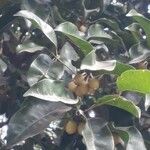Trees, to 20 m tall, crown wide, d.b.h. 30-50 cm. Bark gray to gray-white, smooth. Main branches producing aerial roots which can develop into new trunks; branchlets gray-white, pendulous, glabrous. Stipules caducous, lanceolate, 0.6-1.5 cm, membranous, glabrous. Petiole 1-2 cm, adaxially sulcate; leaf blade ovate to broadly elliptic, 4-8(-14) × 2-4(-8) cm, ± lea-thery, glabrous, base rounded to cuneate, margin entire, apex shortly acuminate; secondary veins 8-10 on each side of midvein, parallel, anastomosing near margin, indistinct from tertiary veins. Figs axillary on leafy branchlets, paired or solitary, purple, red, or yellow [or red with white dots] when mature, globose to depressed globose or sometimes pear-shaped, 0.8-2 cm in diam., glabrous or pubescent, base attenuate into stalk, sessile; involucral bracts inconspicuous, triangular-ovate, glabrous, persistent. Male, gall, and female flowers within same fig. Male flowers: few, shortly pedicellate; calyx lobes (3 or)4, broadly ovate; stamen 1; filament rather long. Gall flowers: many; calyx lobes (3 or)4 or 5, narrowly spatulate; ovary ovoid, smooth; style ± lateral, short. Female flowers: sessile; calyx lobes 3, shortly spatulate; style ± lateral, short; stigma enlarged. Achenes ovoid-reniform, shorter than persistent style. Fl. Aug-Nov.
Large banyan (sometimes lithothytic scrambler), glabrous; adventitious roots few to none; branches somewhat weeping. Leaves subdistichous; lamina elliptic to ovate or lanceolate to oblanceolate, rarely oblong, 3–12.5 cm long, 1.5–6 cm wide, cuneate to rounded (or occasionally cordate) at base, entire margin, acute to acuminate at apex, coriaceous; lateral veins 6–13 pairs (15–20 pairs, fide Dixon 2011: 8); petiole 4–18 mm long, 1–2 mm wide; stipules 0.8–2 cm long, smooth. Figs axillary, usually sessile, ellipsoidal, ovoid, obovoid or rarely subglobose, 8–12 mm diam., ripening dark red (pink, red, purple or black, fide Cooper & Cooper 2004: 322); pedicel if present thick; ostiole enclosed by 3 flat apical bracts in a disc 2 mm diam., often with a rim; basal bracts 2 or 3, to 1.5 mm long, concealed beneath fig-body. Male flowers abundant, pedicellate; tepals 3. Female flowers sessile; tepals free, 3 or 4. Gall flowers pedicellate; tepals 3 or 4.
A fig. It is an evergreen tree. It grows to 12-30 m high and spreads to 4-15 m across. The stem is erect and slender. It has irregular flanges along it. The trunk can be 30-50 cm across. The branches can hang over and the leaves hang down. The plant can produce aerial roots from the largest branches. The bark is smooth and pale grey. The leaves are simple, green and glossy. They are darker on top. The are leathery and oval and taper towards the tip. Leaves are 5-13 cm long and 2-4.5 cm wide. The leaf stalk is 1 cm long. The flowers are very small. There are separate male and female flowers enclosed in a receptacle or fig. The fruit are dark red and small round figs. They are 1 cm across. They are produced in pairs. Some varieties occur based on the size of the figs.
Trees , evergreen, to 10 m. Roots adventitious, occasionally hanging. Bark gray, smooth. Branchlets brown, glabrous. Leaves: stipules 0.8-1.2 cm; petiole 0.5-2(-3) cm. Leaf blade oblong, elliptic, lanceolate, or ovate, 4-6(-11) × 1.5-6 cm, nearly leathery, base rounded or cuneate, margins entire, apex acuminate or cuspidate; surfaces abaxially and adaxially glabrous; basal veins 1(-2) pairs, short; lateral veins (6-)12(-14) pairs, regularly spaced, uniform; secondary veins prominent. Syconia solitary or paired, sessile or subsessile, orange, yellow, or dark red, nearly globose, 8-12 × 7-10 mm, glabrous; subtending bracts 2-3, crescent-shaped, 0.5-1.5 mm, glabrous; ostiole closed by 3 small, flat, apical bracts 1.5-2 mm wide, umbonate.
Tree. Blade narrowly elliptic to ovate, up to 12 x 6 cm, apex acuminate, base acute to rounded; secondary vein pairs 6-16. Figs sessile, 0.6-1.2 cm in diam., becoming yellow, orange or red.










